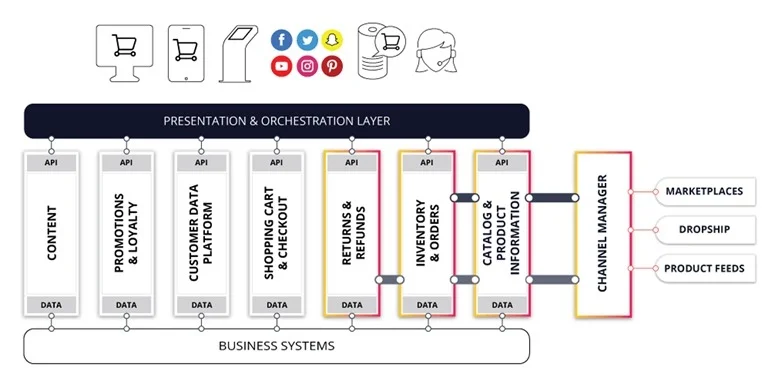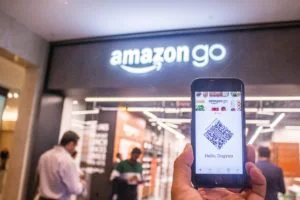What is Composable Commerce?
Composable commerce is a term, coined by Gartner in a June 2020 report, referring to a modular digital commerce approach referred to as composable architecture. This kind of modular approach enables the selection of best-in-breed solutions for each unique business need to assemble a customized tech stack.
Composable commerce is the modern way of building complex enterprise commerce systems.
While monolith relied on a single vendor to provide a standard solution, Composable commerce system is composed of independent software components, each providing a particular business capability.
ARCHITECTURE OF COMPOSABLE COMMERCE
- Services can only communicate via APIs
- Technology used to build services is irrelevant as long as APIs are exposed
- Services are deployed separately and can be scaled independently
- Services do not share a common data store
- Storefront is separate from any other module, services are headless

Let’s look at the four key tenets of composable commerce:
1. Modular – Each component of the system — smarter cart technology, customer relationship management (CRM) system, etc. — can be deployed and interchanged independently.
2. Open – Applications can be seamlessly integrated, Freedom of choice between technology stacks
3. Flexible- With unique stack, ability to use modern frontends and support other channels (PWA)
- Business-centric- Customizable system enables rapid response to changing business requirements, increasing potential innovation. Outstanding time-to-market due to ready-to-use components
Evolution of Composable Commerce
The front-end interface that customers interact with is tied to the back-end that controls everything behind the scenes. Composable commerce is the latest in a series of steps away from the traditional, all-in-one software monolith. These platforms can be rich in features and functionality, but they are not nimble, and they tend to slow business innovation rather than enable it.
1. The problem with monoliths.
2. Headless commerce.
3. MACH architecture.
4. Composable commerce.
Advantages of Adopting Composable Commerce
Modern Commerce, from Monolith to Composable Commerce “Physicalizing” Digital Experiences is the need, The simple fact is: people enjoy shopping. There’s the social aspect of going to a shopping center with family or friends, grabbing a coffee or a bite to eat, and getting the opinion of who they’re with if they should buy an item that’s caught their eye. Live Streaming, Group Buying, Subscriptions and more use cases emerge along with BOPIS for merging the Online and Brck and Motor journey to true OMNICHANNEL
Digital transformation and transitioned their technology foundation from a traditional, monolithic, legacy platform to a modern, API-driven, cloud-native system, were the ones to come out on top Decthalon and Chalhoub is a perfect example. The company began its journey in 2017 and had become one of the first brands to offer BOPIS (buy online, pickup in store). When COVID-19 hit, the retailer was met with an onslaught of orders for home Gym equipment, virtual Yoga Classes, Gym Instructors, Sport coaches. Not only was their open, scalable system easily able to handle the increased volume, it also allowed them to deploy a contactless curbside pickup ordering solution within weeks.4 While other retailers were shutting down across the country, Decathalon was serving the new needs.
Few other players made a smart decision to immediately transition to a Composable Commerce platform – and quickly discovering the risk was worth the reward. Case in point: Apollo Pharmacy and Chalhoub Group
The future of commerce technology are real cloud- and microservice-based, API-centric, headless solutions – the ones that follow MACH principles Why microservices, APIs, cloud and headless (MACH) are disrupting OMNICHANNEL Technology Needs MICROSERVICES BUILD EASY (M) – A microservices-based commerce platform gives the flexibility to pick and choose where to focus development and business priorities. And, because each microservice is deployed independently, developing, testing and maintaining it is much, much easier.
API-FIRST MATTERS (A) – An API-first approach makes a difference for commerce in so many ways. First, using APIs lets you easily call on the data you need. Even better, APIs make it simple to bridge different systems together—a CRM and CMS, API-first approach makes it easy to integrate connected cars, smart home applications, chatbots. Platform that supports GraphQL and REST CLOUD-NATIVE FOR PACE AND AGILITY (C) By choosing a cloud-native commerce platform, not only are applications hosted in the cloud, they’re also developed in the cloud. Every step— from development to testing to microservices deployment
HEADLESS: A SINGLE SOURCE OF TRUTH (H) – A headless platform decouples the front end of the commerce infrastructure from the back end, development and business teams to work independently without impacting each other.
Disadvantages of Adopting Composable Commerce
There are clearly a number of advantages to a composable commerce approach, which explains why many enterprise-scale businesses are moving in that direction. However, there are some potential roadblocks and challenges you’ll need to consider, particularly if you’re eyeing a full microservices approach versus a headless ecommerce platform.
- Manage multiple vendors.
- Require high digital maturity levels.
- Change infrastructure and monitoring tool needs.
- DIY control panel.
Implementing a Composable Commerce Solution
You may be wary of the effort that goes into the replatforming process, but there’s good news on that front. Fortunately, switching from a monolith to a microservices or headless platform may be done incrementally by slowly reducing reliance on the core monolith.
With an incremental approach, you can first decide which capabilities to decouple and when to slowly separate your entire monolith into a system of microservices. You can start transitioning to your new platform while you’re still building out the rest of the parts.
Wrapping Up
Consumers are experiencing products and interacting with brands in more ways than ever before. Social media channels have become sales channels, marketing channels and customer service channels. We buy on marketplaces, at pop-up events, on our mobile devices and sometimes even through smart speakers or game systems. Commerce is omnichannel.
“There are five generations who are buying things online, and never before have merchants or brands been tasked with marketing and selling to five different generations who have incredibly different expectations.
Delivering personalized commerce experiences at scale requires flexibility.
There are plenty of good reasons to choose an approach with some degree of composability, but there are drawbacks to that approach as well. Before jumping into any technology decisions, make sure you have a 360-degree view of your business needs, internal and external development capabilities and the way any technology might impact your business or processes.
Retail Insights: THE WORLD’S MOST FOCUSSED OMNICHANNEL TECHNOLOGY COMPANY, was the early starters headless commerce platform development. As the pioneer in its field, designed to support both current and future methods for conducting OMNICHANNEL in mind.
That makes RETAIL INSIGHTS the choice of forward-thinking businesses that want a high-performing, easily maintainable solution that is continuously at its prime.
RETAIL INSIGHTS expert team help you to develop commerce which is cloudnative and, of course, incredibly scalable, giving you more flexibility than any other platform. It’s that simple.




